
When you’re caught up in the magic of CES (Consumer Electronics Show), it’s pretty hard to tell what is going to be the next great movement/idea and what is going to be a yeah … but.
It’s impossible to “see” all of CES because it takes up about 35 football fields of space but there were a lot of the 170,000 attendees who tried their damndest.
Suckers!
This year’s show was one of the most vibrant in the past 10 years.
On the flight home, I thought about the first three categories – wearables, autos and 4K TV.
Wearables
To show you how quickly wearables are changing and hunting for markets/customers I fortunately didn’t see one pair of Google Glass walking the floor this year.
Don’t get me wrong, there are places for the technology but it’s in market segments like field service, law enforcement, warehouse, factory floor and others; not walking down the street.
It’s bad enough we never look up from our iPhone while walking or don’t pocket them while dining.
True, as you walked the Sands Expo area, you saw plenty of new glasses that didn’t get the word that Glass didn’t fly last year, but they’ll keep trying. They ranged from ugly to fairly good to acceptable in mixed company.
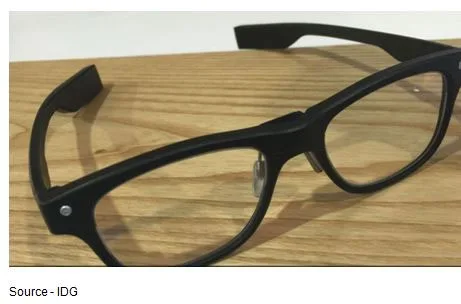 Not Dumb Looking – There are vertical applications for “computerized” glasses as long as they don’t make you look dumb. Jins was one of the few firms we’ve seen that didn’t want make you want to punch the intelligent glasses wearers.
Not Dumb Looking – There are vertical applications for “computerized” glasses as long as they don’t make you look dumb. Jins was one of the few firms we’ve seen that didn’t want make you want to punch the intelligent glasses wearers.
Jins, a Japanese firm, had one of the few that was not only smart but did a great job of hiding its smarts.
Everyone was showing his/her smartwatch, fitness band, bandage, monitoring device, jewelry.
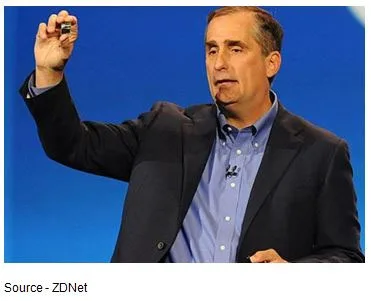 My Button – Intel’s CEO Brian Krzanich literally popped his buttons with pride as he showed off the work his firm is doing with wearable and robotic manufacturers around the globe.
My Button – Intel’s CEO Brian Krzanich literally popped his buttons with pride as he showed off the work his firm is doing with wearable and robotic manufacturers around the globe.
Intel seemed to be a prime mover in the wearables area with their new itty-bitty Curie chip.
They seemed to be driving the product category, assisting any company who would talk with them.
Everyone had a smart watch on their wrists that was colorful and could talk to your phone or some other device.
Each was less spectacular than the last one and they were all waiting to reinvent their watch when the Apple Watch is introduced in a few months.
There were wearables for babies, kids, dogs, cats and yes, even you.
Everyone was hell-bent on convincing you their smart whatever was better than the next guy’s and worth the investment.
The area that seems to hold the greatest potential is in the healthcare monitoring category–especially when they’re connected/monitored by your physician or hospital system; but that segment has a lot of legal hurdles to jump.
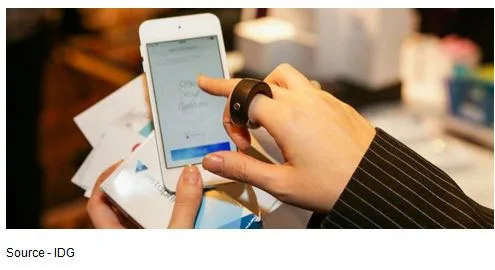 With this Ring – The Finger Ring got a lot of attention at CES and ShowStoppers as a wearable. It is usable but her middle finger is still a little too “in your face” to be a long-term winner – IMO.
With this Ring – The Finger Ring got a lot of attention at CES and ShowStoppers as a wearable. It is usable but her middle finger is still a little too “in your face” to be a long-term winner – IMO.
One smart wearable that was O.K. was the smart ring which solves the problem for people who have a phobia about touching their touch screen or a switch.
The fitness wearables were everywhere … except on the folks who really needed them. Those folks will probably buy two or three this year just to show how attentive they are.
The general consumer category of wearables though was mostly cheap (looking) or gawdy. That’s one of the biggest issues the folks who are hoping to win big in this category have … you see the stuff.
Some of the industry analysts are wildly optimistic about sales this year but people like IDC and TECHnalysis Research, are much more cautious, saying it’s going to take three – five years for the market to be really big.
The two research firms say there is going to be a general wearables market made up of products you wear and use but that don’t stand out or talk about themselves every time you wave your hand (or finger).
The bigger and more profitable area will be in the niche applications, whether it’s healthcare, engineering, production, service, whatever.
But they all require an app to make themselves useful and valuable.
Naturally, the pre-millenials are leading the way in adopting the wearables. According to Ipsos, the fitness devices are usually purchased by the 18-34 year-old crowd (31 percent).
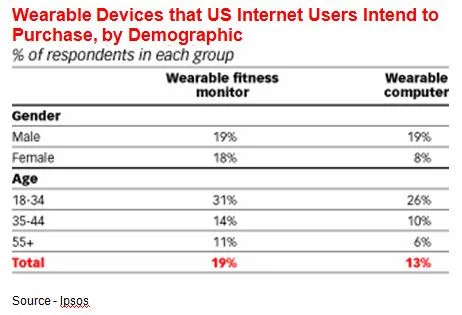 Leading Wearers – The early adopters of wearables are the pre-millenials; but even they are looking for real applications and usage rather than “see what I have.”
Leading Wearers – The early adopters of wearables are the pre-millenials; but even they are looking for real applications and usage rather than “see what I have.”
People like Generator Research estimate that about 5.8 million smartwatches will be sold this year; but by 2020, sales will climb to a whopping 3l3B units.
Of course, Jupiter and Forrester Research, which are more realistic, say sales will reach about 36 – 40 M units by 2018.
Whether you’re in charge of marketing the devices or considering a purchase, your enthusiasm may vary.
Most sane people seem to agree that there is modest interest in buying the newest thing to wear and show off this year even though the next CES will have a bigger, badder, cheaper batch.
And, of course, that purchase comes right after a new smatphone, smarter car and smart 4K UHD TV.
Mo’ Betta Cars
It’s been a couple of years now since CEA’s Shapiro sweet- talked a couple of the auto manufacturers into showing off their new technology at CES; and this year, they were freakin’ everywhere.
Face it, people have a love affair with their iron horses – even if they are modest.
Nvidia – long a leading GPU (graphics processor unit) leader for gaming and other process- intensive jobs – has quietly taken the lead in this area and it almost looks like they own the lion’s share of the automotive/transportation industry.
 Car’s Heart – Nvidia’s CEO, Jen-Hsun Huang, showed the firm’s new chip technology which was designed to become an integral part of tomorrow’s cars. Word is that an increasing part of the transportation industry’s design is hardware/software centric.
Car’s Heart – Nvidia’s CEO, Jen-Hsun Huang, showed the firm’s new chip technology which was designed to become an integral part of tomorrow’s cars. Word is that an increasing part of the transportation industry’s design is hardware/software centric.
Nvidia’s CEO, Jen-Hsun Huang, has become very focused on making their newer chips an integral part of every car on the road.
I got an advanced look at all the work/design wins they have when Nvidia’s Danny Shapiro, discussed the firm’s reshaped technology for the auto industry in Rob Enderle’s panel at Storage Visions the day before CES.
Impressive!
One of the reasons is that more and more of the coming generations of cars will come with a continuing stream of software updates like Tesla’s new X model, which was proudly displayed at the show.
There were plenty of self-driving and automated car technologies at the show in cars that ranged from Mercedes, BMW, Audi, GM. etc. that would drive you around a course, park itself, monitor the driver and vehicles around you and more.
And whether they were fossil-fueled or battery-powered, they looked really awesome!
This year, auto folks and their hardware/software providers took up a good chunk of CES including Mercedes with their self-driving future car, Audi with all of their advanced technology, Volkswagen with super intelligence and all of the rest of the folks showing off gotta’ have technology (and style).
Still, you wonder what in the h*** car companies are doing at CES until you know that according to Accenture, technology represents 50-60 percent of your car’s bill of materials.
There’s probably no better example of that than Ford, which was one of the first auto manufacturers to display and keynote at CES.
CEO Mark Fields likes to think of his company as more than a vehicle producer. He thinks of it as a transportation analytics firm.
The company still pays plenty of attention to style; but they also venture into new (almost foreign) areas like safety/security issues, transportation and smart city/roads analytics.
Ford is also examining areas that they cared less about a few years ago like driving patterns, parking apps, insurance and what people will require in transportation in 10 years.
According to Fields, today’s cars are a mass of computing technology, producing upward of 25GB of data an hour.
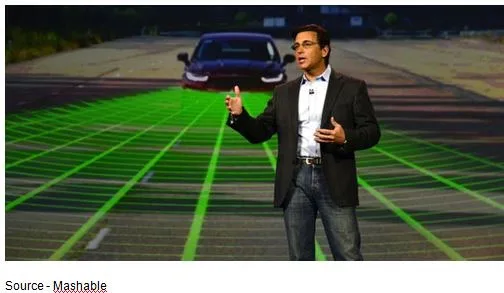 Tech and Concern – Ford’s CEO Mark Fields discussed the firm’s transformation at CES from just a car company to a technology company that was exploring all of transportation’s applications and implications.
Tech and Concern – Ford’s CEO Mark Fields discussed the firm’s transformation at CES from just a car company to a technology company that was exploring all of transportation’s applications and implications.
Talking more like IT folks than car producers, all of the car booth people talked about how (with the user’s permission they emphasize) they can collect performance data and enhance the car’s infotainment systems.
They tell you it’s all about streamlining and customizing the user experience.
They want the car to be as customizable and user friendly as your iPhone so you just think it’s an extension of you.
Of course, there are a couple of gotchas’ there as well.
First, the average car on the road today is 10 plus years old, so taking advantage of all those features are only reasons to justify an “upgrade” for most folks.
The second issue is the security of your driving system.
Fields and his contemporaries talked at length about keeping the cars safe from hackers so they wouldn’t become guided missiles barreling down the road.
They are probably spending as much on advanced encryption and security technology as they are in their advanced systems because it has to be a big concern for anyone who is considering one of these new marvels in a year or two.
Yes, I have my eyes on a couple of driving computers. But it’ll take a little work to convince my wife it’s a great investment.
Smart, Beautiful
Just before CES I had an online “discussion” with a marketing expert who said 4K UHD TVs were a total waste of money because the quality of imagery just wasn’t there.
I pointed out that over the holidays, Costco was selling a 60-in smart 4K set for a rockin’ $900 and that the image presentation wasn’t just “good enough,” it was spectacular. I also noted that the volume of 4K content was growing much faster than he said.
Unlike a few years ago, when people thought 3D was going to take over the entertainment industry, 4K is here and it’s damn good!
Samsung and LG prepared for it and announced display areas that seemed as big as most warehouses.
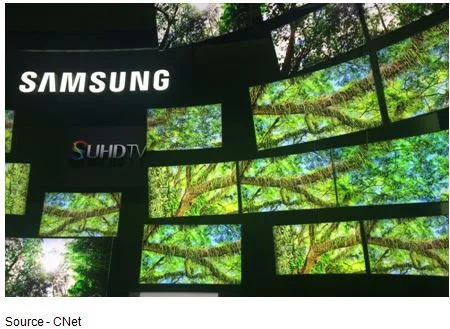 Big, Bigger – There was nothing small about the way 4K UHD TV set manufacturers bragged to the world about their new (and surprisingly inexpensive) entertainment screens. The screens were big but their booths were huge.
Big, Bigger – There was nothing small about the way 4K UHD TV set manufacturers bragged to the world about their new (and surprisingly inexpensive) entertainment screens. The screens were big but their booths were huge.
Sharp is ready too and unveiled a breathtaking new family of Quattron “Beyond 4K” sets. They’re the first to deliver 8K-like pictures even though I’m still very happy with our 55-inch smart 4K UHD set.
I’m not clear as to the advantage of some of the curved 4K sets that were introduced, but I suppose it’s a little closer to an IMAX experience; so if you don’t have your intelligent, brilliant home screen yet, they do deserve a consideration, especially if you let your kids play video games on them.
The unveiling of 4K TVs is complemented by the fact that the industry has moved very quickly to expand the 4K lineup. Every major studio and production company is working in 4K and that even includes the non-traditional houses like YouTube, Yahoo Studios and AOL Video.
Sony already has more than 170 4K features and TV episodes and Netflix has been producing (and bragging about) their 4K series for a couple of years already.
Sony notes that they have been scanning and upconverting their huge library of content to 4K as quickly as possible.
Meanwhile, firms like 4K Studios report they are repurposing more than 70 titles a month for producers and content owners to deliver a better, high dynamic range; wider color space and higher frame rates to meet consumer expectations.
Every video library owner is either doing the same themselves or farming out the work in return for shared revenues or front-end payments.
While M-Go is pushing content to 4K by upscaling it, Sony and most studios say they prefer the upconversion path because it delivers the level of viewing quality people should expect with the new dynamic range 4K UHD sets.
One of Sony’s executives at a 4K preparation session said that people can almost immediately see the difference when a segment has been shot/presented in 4K or upconverted compared to upscaled. “Once you see them side by side, you know the difference,” he emphasized.
Samsung, LG, Vizio and several other smart 4K UHD set manufacturers seem to agree because they were all displaying their sets by streaming Netflix and NanoTech’s UltraFlix, the all-4K channel with more than 500 hours of entertainment.
An LG executive told me the big difference wasn’t just in the viewing quality between the two approaches but also the bandwidth required by each.
Netflix generally requires a bandwidth of 25Mb; but because of the pre-processing done with the UltraFlix streaming content, it can be streamed without pixel loss, stuttering or frame drops over 10 Mb pipes, which is about average for the U.S.
While Blu-ray sales have fallen dramatically since people began time-shifting their shows and OTT (over-the-top) streaming has become popular (cutting the cable), the industry is looking for Ultra HD Blu-ray to be available later this year and some movies/shows are expected to be available on UHDBD (I don’t know what they’re going to call it) by the end of the year.
Of course, they overlook the fact that you’ll also have to invest in a player, which will probably be backward to BD and earlier formats … probably.
As a sign that the Internet delivery is firmly taking hold, all of the major networks CBS, NBC, ABC, Fox, etc. are not only streaming their content but also investing in 4K cameras as well as production and distribution equipment.
What they have also found is that the OTT viewer also likes to peek at the stuff in their vaults so they are repurposing films and series as quickly as they can.
Yes, the good old stuff you watched as a kid could be available in spectacular 4K and it will look like something brand new because your memory isn’t what it was back then.
And just imagine, you’ll be able to control the channel surfing with your new wearable whatever or even go out in the garage and watch it with your smart car.
How’s that for a 4K ecosystem?